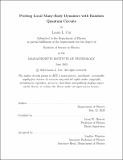Probing Local Many-Body Dynamics with Random Quantum Circuits
Author(s)
Cui, Laura L.
DownloadThesis PDF (762.6Kb)
Advisor
Harrow, Aram W.
Terms of use
Metadata
Show full item recordAbstract
Random quantum circuits are an attractive model for the behavior of complex many-body physics, due to their analytic tractability as well as ability to reproduce the behavior of chaotic quantum systems. Recent progress in elucidating their structure has led to an improved understanding of quantum complexity, both in the context of quantum circuit complexity and state preparation, as well as for the task of measuring and distinguishing quantum states. However, previous results in the literature often rely on the properties of specific theoretical models, or require unrealistic assumptions about the dynamics and experimental realization of large systems.
In this thesis we discuss the application of random circuits to probe local dynamics in many-body systems, focusing on the regime in which the depth of the circuit is small compared to the size of the system. Motivated by recent results, we provide a definition for local scrambling based on the difficulty of distinguishing the resulting distribution from a Haar-random transformation in the case where only a region of fixed size may be accessed. We prove that up to the second moment, local scrambling of a product state input occurs in log depth, i.e. requiring circuit depth at most proportional to the logarithm of the size of the region, and is independent of the total system size.
In addition, we consider models for classifying topological phases and characterizing the entanglement structure of quantum matter. In particular, we describe the immediate application of our above result to bounds on the detection of these phases. We then discuss the topological entanglement entropy (TEE), a quantity related to the quantum conditional mutual information. Under standard assumptions, we prove that in the trivial phase, spurious contributions to the TEE decay in the limit as the size of the system goes to infinity, suggesting that the TEE is a robust indicator of topological order.
Date issued
2023-06Department
Massachusetts Institute of Technology. Department of Physics; Massachusetts Institute of Technology. Department of MathematicsPublisher
Massachusetts Institute of Technology